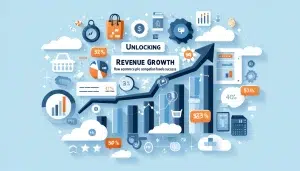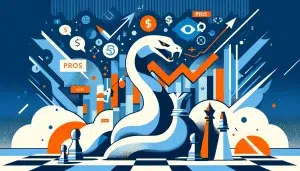In a fiercely competitive ecommerce landscape, understanding the psychological impact of pricing strategies is crucial as it directly affects the ability to attract and retain customers.
Pricing is not merely a numbers game; it’s a delicate dance between perception and reality. Customers’ purchasing decisions are influenced by a myriad of psychological factors, and understanding these nuances can unlock a world of opportunities for your business. What strategies you utilize for product pricing can prove to be highly advantagious in the fiercely competitive arena of ecommerce.
People’s purchasing decisions are driven by complex psychological factors that savvy businesses can leverage to maximize their profits. This comprehensive guide delves into the intricate interplay between consumer psychology and pricing analysis, equipping you with the tools to captivate your target audience and maximize your bottom line.
The Pricing Strategy of Perception
Have you ever wondered why some stores omit the dollar sign from their price tags? This subtle tactic is rooted in the psychological principle of perception. Studies have shown that when prices are listed without a dollar sign, customers tend to spend more freely, as the numerical value appears less tangible and less connected to the concept of money.
In a fascinating experiment conducted at a restaurant within the Culinary Institute of America in Hyde Park, New York, researchers presented three types of menus: one with prices listed with a dollar sign, another without, and a third with the word “dollar” spelled out. The results were striking – customers spent significantly less when the dollar sign was present, suggesting that the mere presence of this symbol triggered a heightened awareness of spending.
What becomes evident is that as a business, you have the power of influencing your customers buying habits through manageable strategies. It might be by implementing time-limited deals, two-for-one promotions, or one day only sales. It creates the perception that if your customers doesn’t act now, they will miss out. It can ignite customer interest, boost website traffic, and elevate brand awareness.
However, it is crucial to strike a delicate equilibrium and refrain from excessive utilization of discounts, as this may compromise the perceived value of the brand.
Here you can find a nice video about his
Tracking Competitor Pricing
By tracking the pricing of your competitors, you can create a framework for your business to incorporate a well-defined pricing strategy that is tailormade to your customer’s needs. In the world of ecommerce, your products or services do not exist in a vacuum and the only way to understand the diversity of the business landscape is to track what your competitors with their pricing strategies.
Let’s say you want to sell shoes online and you need to compile a comprehensive list of the top shoe sellers in the ecommerce that would be your competitors. Monitoring their online prices is vital, yet manual tracking can be time-consuming and labor-intensive. Leveraging automated price tracking software can streamline the process. These tools will provide you with real-time updates on your competitors’ pricing moves, enabling you to make informed decisions swiftly.
In this way, not only can you compare your products or services to those of your competitors, you can identify strengths, weaknesses, and opportunities for differentiation. The analysis not only informs you about pricing strategy but also offers valuable insights into your product’s performance and market positioning.
It can help you identify opportune moments to offer more attractive deals, thereby gaining a competitive edge. Another advantage of automated tracking is that it enables swift, data-driven pricing adjustments that align with your overall product pricing strategies.
The Emotional Benefits in Pricing Strategies
Pricing isn’t solely about numbers. It also has the power to forge emotional connections with customers. By highlighting the benefits and value propositions of your products or services, you can create a psychological link between the price and the perceived value in the minds of your customers.
Imagine a scenario where your product page features a dedicated section that explains how your offering can solve a specific problem or enhance the customer’s life. This approach not only fosters a deeper understanding of your product’s core functionality but also cultivates a positive brand image, ultimately increasing the likelihood of a purchase.
Encouraging this emotional connection with your customers means you need to regularly evaluate and adjust pricing strategies based on market conditions and customer feedback to remain agile and responsive in the marketplace.
Mastering the Art of Pricing Analysis
We’ve discussed the power of understanding consumer psychology, but it is merely the first step in the journey towards maximizing profits. You also need to understand the power of conducting comprehensive pricing analysis, a process that empowers you to identify the ideal price point for your products or services.
And much like pricing strategies, you need to conduct this research for your product as well as your competitors. It involves putting together a pricing analysis that involves various factors such as market demand, production costs, competitor pricing, and consumer behavior. By understanding these elements, businesses can determine the ideal price for their products or services that aligns with market expectations and offers value to customers. Regardless what you sell, in ecommerce, where pricing directly influences customer purchasing decisions, understanding it is critical.
Three Effective Pricing Analysis Strategies
The “sweet spot” in pricing strategies is the key point where customers perceive the price as reasonable, and the business generates a satisfactory profit margin. Achieving this balance within pricing strategies requires carefully considering various factors:
1. Identify and Analyze Your Target Audience
Before embarking on pricing analysis, it is imperative to identify and thoroughly analyze your target audience. This step ensures that your pricing strategy aligns with the preferences, behaviors, and expectations of the customers you seek to attract.
Observe how your existing customers react to various pricing strategies, promotions, and discounts. Identify the products or services that resonate most strongly with them, and use these insights to refine your pricing approach. Remember, your pricing strategy should be a harmonious extension of your overall business strategy, reflecting your brand image and long-term goals.
2. Track Competitor Pricing
In the dynamic world of ecommerce, your products or services do not exist in a vacuum. To truly understand the market landscape, it is essential to track the pricing strategies of your competitors meticulously.
Imagine you are selling shoes online. Compile a comprehensive list of the top shoe sellers in the ecommerce realm, and diligently monitor their online prices. While manual tracking can be time-consuming and labor-intensive, consider leveraging automated price tracking software to streamline the process. These tools will provide you with real-time updates on your competitors’ pricing moves, enabling you to make informed decisions swiftly.
By comparing your products or services to those of your competitors, you can identify strengths, weaknesses, and opportunities for differentiation. This analysis not only informs your pricing strategy but also offers valuable insights into your product’s performance and market positioning.
3. Solicit Customer Feedback
Conducting pricing analysis surveys is a cornerstone of effective pricing strategies and can yield invaluable insights into customer expectations and willingness to pay.
Open-ended questions, strategically integrated into these surveys, encourage authentic feedback, fostering long-term customer relationships and loyalty. By incorporating pricing strategies into the survey methodology, businesses can gain a comprehensive understanding of how their target market perceives the value of their products or services. This can inform crucial pricing decisions and enable organizations to optimize their pricing strategies for maximum profitability. Thus, pricing strategies should be considered an integral component of any well-rounded market research endeavor.
Businesses can ask customers about their typical spending habits, expected prices for specific products, perceived value compared to competitors, and how pricing strategies influence their perception of a product’s quality. Additionally, inquiring about purchasing priorities, such as quality, price, reliability, or brand reputation, can inform pricing strategies.
Maximize Profits Holistically
Pricing is not a isolated endeavor; it is a multifaceted strategy that requires a holistic approach to truly maximize your profits and achieve sustainable growth.
The key steps in this process include:
- Identifying and analyzing the target audience to tailor pricing strategies to their preferences and behaviors.
- Highlighting product benefits to create a psychological link between price and perceived value.
- Tracking competitor pricing to identify opportunities for differentiation and competitive advantage.
- Soliciting customer feedback to gain insights into their expectations, willingness to pay, and purchasing priorities.
Recap on Pricing Strategies
By implementing these strategies, businesses can find the optimal pricing sweet spot, foster long-term customer relationships and achieve sustainable growth in the ecommerce landscape. Understanding the psychology behind strategic pricing and analysis is a powerful tool for businesses seeking to maximize profits.
To be competitive and drive sales, you need to be tapping into consumer perceptions of value. It’s about strategically positioning your products or services in a way that resonates with your target audience, leading to increased sales and customer loyalty.
In doing so, you can leverage pricing as a means to communicate value, build trust, and differentiate your business from competitors. A well-crafted pricing strategy not only impacts immediate sales but also contributes to the overall brand perception and customer satisfaction, laying the foundation for sustained growth and success.
You don’t need to become a psychological expert, but you do need to delve into the psychology of pricing deep enought for you to be able to conduct a thorough analysis that will empower your businesses so you can make informed decisions that go beyond short-term gains, ultimately leading to long-term customer relationships and sustainable growth in the ever-evolving ecommerce landscape.
Here some links you could find interesting about Pricing Strategy topic:




